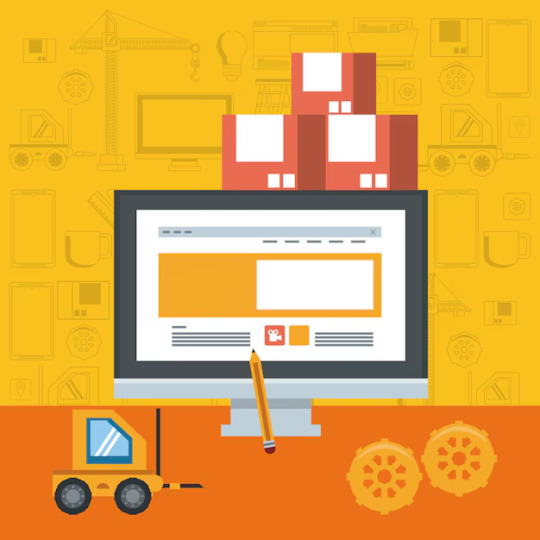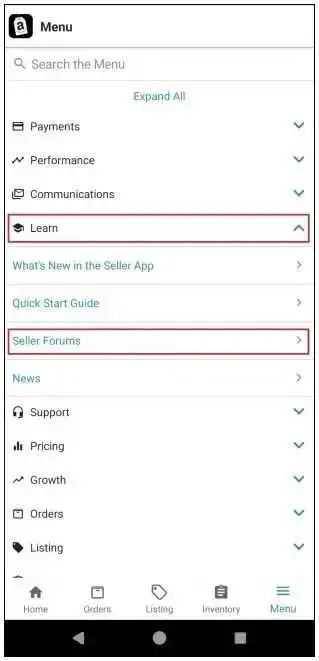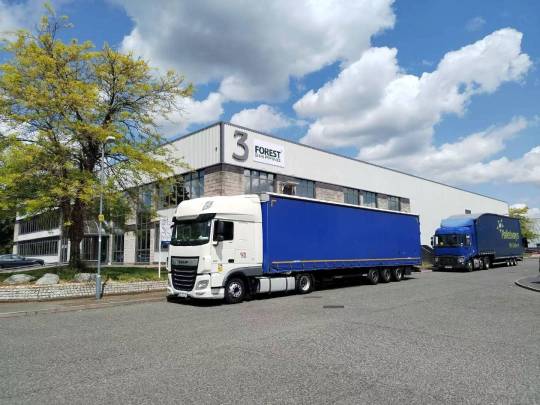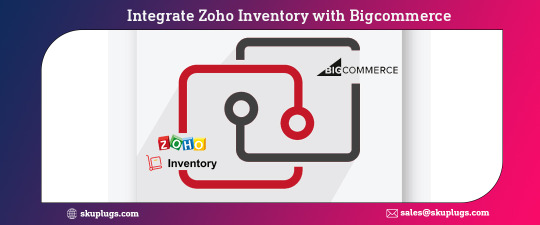#synchronizing inventory quantities
Explore tagged Tumblr posts
Text
How the Best Inventory Software Helps UAE Businesses Stay VAT-Compliant

Since the introduction of Value Added Tax (VAT) in the UAE in 2018, businesses across industries have been required to maintain accurate records and submit timely VAT filings. While this has brought a higher level of transparency and revenue to the government, it has also increased the administrative burden on businesses. One of the most effective ways to manage VAT compliance effortlessly is by using robust inventory management software.
In this blog, we explore how the best inventory software can help UAE businesses stay VAT-compliant and avoid costly penalties.
1. Real-Time Inventory Tracking for Accurate VAT Records
Inventory software allows businesses to track goods as they move in and out of the system in real time. Whether it's incoming stock from suppliers or outgoing sales to customers, each transaction is automatically logged with details like date, quantity, and price — all crucial for VAT records.
By maintaining updated inventory data, businesses can ensure that all taxable goods are accurately accounted for, eliminating discrepancies that may raise red flags during a tax audit.
2. Automated Tax Calculations
Modern inventory software comes with built-in VAT calculation capabilities. When integrated with invoicing and sales modules, it can:
Automatically apply the correct VAT rate to taxable items
Distinguish between standard-rated, zero-rated, and exempt items
Generate VAT-inclusive or exclusive invoices as required
This reduces human error and ensures that tax amounts are correctly calculated and reported, providing peace of mind for UAE business owners.
3. Seamless Integration with Accounting Systems
Top inventory management solutions in the UAE integrate easily with accounting software. This means that every purchase, sale, or stock adjustment automatically updates the financial records. As a result, VAT-related data such as Input Tax (from purchases) and Output Tax (from sales) is accurately reflected in the accounting ledger.
With synchronized systems, filing quarterly VAT returns becomes faster, more accurate, and less stressful.
4. Simplified VAT Reporting and Audit Trail
The Federal Tax Authority (FTA) in the UAE requires businesses to maintain proper documentation and be ready for audits. The best inventory management software provides:
Comprehensive reports on purchases, sales, and stock movements
A complete audit trail with timestamps and user logs
Exportable data formats compatible with FTA submission requirements
This not only simplifies the preparation of VAT returns but also ensures you are fully compliant during surprise inspections or formal audits.
5. Support for Multi-Location and Multi-Warehouse VAT Compliance
For businesses operating in multiple locations across the UAE, VAT compliance can become complicated. Inventory software designed for the UAE market offers multi-location and multi-warehouse support, allowing businesses to:
Track inventory movements between branches or warehouses
Manage inter-branch transfers with appropriate tax treatment
Consolidate VAT reporting across different locations
This ensures your entire operation complies with local VAT laws without requiring separate systems for each location.
6. Improved Accuracy with Barcode and Batch Tracking
Inventory solutions with barcode scanning and batch/serial tracking capabilities help businesses reduce manual errors and maintain precise stock records. This is particularly useful when VAT is calculated based on unit cost or inventory valuation methods like FIFO or average costing.
Accurate tracking means accurate valuations, and by extension, accurate VAT calculations — a key requirement for businesses in sectors like retail, pharmaceuticals, and electronics.
7. Customizable for UAE Tax Rules
The best inventory management software solutions in the UAE are VAT-ready out of the box, and many offer the flexibility to adapt to future tax regulation changes. Features may include:
Custom tax rules and codes
Country-specific compliance settings
Arabic/English bilingual support for FTA documentation
This ensures that your business can scale and stay compliant even as tax laws evolve.
Conclusion
Staying VAT-compliant is not just about avoiding fines — it's about building trust with stakeholders, maintaining operational transparency, and ensuring long-term sustainability. The Best Inventory Management Software UAE simplifies VAT compliance by automating tax calculations, integrating with accounting systems, and providing real-time data and reporting.
For UAE businesses aiming to grow in a competitive and regulated market, investing in a VAT-compliant inventory system is no longer optional — it's essential.
0 notes
Text
Lightspeed POS Integration nulled plugin 2.16.6

Unlock Seamless Retail Management with the Lightspeed POS Integration Nulled Plugin Looking to revolutionize your retail operations? The Lightspeed POS Integration nulled plugin is your ultimate solution to streamline online and in-store management. Whether you're a growing eCommerce entrepreneur or a brick-and-mortar business expanding digitally, this powerful plugin bridges the gap between your Lightspeed POS system and WooCommerce store—effortlessly syncing inventory, sales, and customer data. Best of all? You can download it for free from our website and eliminate all the usual licensing hassles. What Is Lightspeed POS Integration Nulled Plugin? The Lightspeed POS Integration nulled plugin is a premium WooCommerce plugin that connects your online store with the Lightspeed Retail POS system. By synchronizing inventory, pricing, and product data in real time, it ensures accuracy across all sales channels. With this nulled version, you get full functionality—absolutely free—enabling you to operate efficiently without the costs of the original license. Technical Specifications Plugin Type: WooCommerce Integration Version: Latest available Compatibility: WooCommerce 6.x and above POS System: Lightspeed Retail (R-Series) Languages Supported: English (default), Multilingual ready File Format: .zip Key Features and Benefits Real-time Sync: Keep your Lightspeed and WooCommerce product catalogs perfectly aligned at all times. Inventory Accuracy: Say goodbye to overselling and stock discrepancies with automatic quantity updates. Unified Reporting: Analyze sales and performance from one centralized dashboard. Time-Saving Automation: No more manual data entry—this plugin takes care of everything for you. Cost-Free Access: Enjoy all premium features without the premium price by downloading the nulled version directly from us. Real-World Use Cases Retailers from various industries use the Lightspeed POS Integration nulled plugin to simplify their operations. Whether you run a clothing boutique, electronics store, or health and wellness shop, this plugin ensures consistency across your sales platforms. It's especially useful for businesses expanding their physical presence into the online space, offering seamless POS integration that scales with growth. How to Install the Plugin Download the plugin .zip file from our website. Log into your WordPress admin dashboard. Navigate to Plugins > Add New, then click Upload Plugin. Select the downloaded file and click Install Now. After installation, click Activate Plugin. Configure the plugin by linking your Lightspeed Retail credentials under the settings menu. FAQs Is the nulled version safe to use? Yes, our Lightspeed POS Integration nulled plugin is thoroughly tested and clean. We ensure no malicious code is included, providing a secure and reliable solution for your WooCommerce store. Do I need a Lightspeed account? Yes, to fully utilize this plugin, you will need an active Lightspeed Retail account. The plugin acts as a bridge between your WooCommerce platform and Lightspeed system. Will I receive updates? While the nulled version does not offer official updates, you can always visit our site to check for the latest releases and improvements. Can I customize the plugin? Absolutely. Since you have access to the full codebase, you can modify the plugin to better suit your store’s specific needs. Get Started with the Best Integration Plugin Today There's no better time to supercharge your WooCommerce store than now. By choosing the Lightspeed POS Integration , you're unlocking premium features without the premium cost. Boost productivity, enhance inventory control, and connect your sales seamlessly—without spending a dime. Looking for even more free tools to enhance your site? Check out our wide selection of nulled WordPress themes to give your store a professional look without the price tag. Need an aesthetic and powerful theme to pair with this plugin? Download woodmart nulled—one of the best eCommerce themes available today.
0 notes
Text
On-shelf availability solution market experiencing robust demand due to rising interest in real-time intelligence
In today’s competitive retail landscape, ensuring that products are available on shelves when customers are ready to buy is more than a logistics challenge it is a strategic imperative. The On-Shelf Availability (OSA) solution market has emerged as a critical enabler for retailers and suppliers aiming to enhance customer satisfaction, drive sales, and reduce operational inefficiencies. As consumer expectations evolve and technological capabilities expand, the on-shelf availability solution market is undergoing rapid transformation, fueled by innovations in automation, data analytics, and artificial intelligence.

Understanding On-Shelf Availability
On-shelf availability refers to the presence of products in the right place, at the right time, and in the right quantities on store shelves. When products are out of stock, not only do sales suffer, but customer loyalty can be eroded. Research indicates that out-of-stock events result in lost sales of up to 8% for retailers, a significant figure in a low-margin industry.
OSA solutions are designed to combat this problem through real-time monitoring, predictive analytics, and responsive replenishment systems. These tools provide end-to-end visibility into the supply chain and store operations, enabling proactive identification and resolution of availability issues.
Market Drivers
Several factors are propelling the growth of the OSA solution market:
Rising Consumer Expectations: Today’s consumers expect seamless shopping experiences, both in physical stores and online. The inability to find desired products in-store often drives them to competitors or online alternatives. OSA solutions help retailers meet these expectations consistently.
Technological Advancements: The integration of IoT, AI, computer vision, and machine learning is revolutionizing how retailers monitor inventory. Smart shelves, RFID tagging, and shelf-scanning robots are increasingly being deployed to automate data collection and improve accuracy.
Shift to Omnichannel Retail: With retailers operating across multiple channels, maintaining accurate inventory across platforms is essential. OSA solutions ensure that inventory data is synchronized, enabling better fulfillment strategies such as buy-online-pick-up-in-store (BOPIS).
Supply Chain Disruptions: Global events such as the COVID-19 pandemic have highlighted the fragility of supply chains. In response, retailers are investing in OSA tools that provide early warnings for potential stockouts and optimize replenishment processes.
Focus on Operational Efficiency: Retailers are under pressure to control costs while improving service levels. OSA solutions support these objectives by reducing manual labor, minimizing inventory holding costs, and streamlining in-store operations.
Competitive Landscape and Key Players
The OSA solution market is characterized by a mix of established technology firms and innovative startups. Key players include Zebra Technologies, SAP, Oracle, Avery Dennison, and Trax. These companies offer diverse solutions ranging from handheld inventory scanners to sophisticated AI-powered image recognition systems that assess shelf conditions.
Retailers are also partnering with supply chain technology vendors and consultants to implement tailored OSA strategies. Customization, scalability, and integration with existing retail systems are critical factors influencing vendor selection.
Challenges to Market Growth
Despite its potential, the OSA solution market faces several challenges:
High Implementation Costs: Advanced OSA technologies can be capital-intensive, particularly for small and mid-sized retailers. The cost of sensors, infrastructure, and training can be prohibitive without clear short-term ROI.
Data Integration Issues: OSA tools must integrate seamlessly with point-of-sale (POS), ERP, and warehouse management systems to be effective. Data silos and legacy systems can hinder real-time visibility.
Privacy Concerns: Some OSA technologies, especially those involving video and image capture, raise concerns about customer privacy and data security.
Change Management: Organizational resistance to adopting new technologies can delay or limit the impact of OSA implementations. Training and leadership support are essential to ensure successful adoption.
Outlook and Opportunities
The future of the OSA solution market appears robust, with steady growth anticipated across global regions. North America and Europe are currently leading in adoption, but Asia-Pacific is expected to experience the highest growth rate due to the expansion of modern retail and e-commerce.
Emerging trends include the use of generative AI to forecast demand with higher precision, edge computing for real-time analytics at the store level, and integration with sustainability initiatives to reduce waste through smarter inventory practices.
Retailers that embrace OSA solutions not only stand to improve availability and reduce lost sales but also gain a competitive edge through enhanced operational agility and customer loyalty. As technology matures and becomes more affordable, broader adoption across all retail tiers is expected.
0 notes
Text
How PrintPLANR Revolutionizes E-Commerce Order Management?
FacebookTwitterLinkedInPinterest
Ever wondered why you run a successful e-commerce business with growing sales, a bustling platform full of orders, yet you find yourself stuck with manual data entry, missing order updates, and delayed order processing? Does that sound familiar?
Imagine trying to keep the demands of your business from piling up—ordering processing done manually, updated customer information across various systems, and hoping that your emails would be sent to customers at the proper time.
It feels like a never-ending cycle, right? But what if we told you there’s a way to eliminate all this manual labor, improve your order fulfillment speed, and keep your customers delighted with real-time updates? What if the solution was as simple as PrintPLANR?
The Problem: The E-commerce Struggle We’ve All Faced
Let’s take a step back and examine the challenges faced by many e-commerce businesses today:
Manual Order Entry:Orders are coming through on your e-commerce platform – say Shopify or WooCommerce. However, each order must be taken and rekeyed manually into your internal system. It is an onerous, laborious, and error-prone process.
Manual Stock Management:Managing inventory manually can be just as time-consuming and error-prone as manual order entry. Without automated synchronization, businesses spend countless hours reconciling stock levels, verifying quantities, and correcting errors. Such inefficiencies not only slow down operations but also increase the risk of losing sales and damaging customer trust due to inaccurate inventory data.
Missing Updates:Even when an order progresses through different stages, there’s a huge lag in updating both your internal system and the customer-facing e-commerce site. As a result, customers aren’t kept in the loop, and your team spends hours playing catch-up.
Email Communication Failures:Did you know that missing an order confirmation or shipping email can lead to frustration and even lost sales? Yet, for many, emails are often delayed or simply don’t sync correctly with the e-commerce platform.This was the reality for many of our customers—until we introduced PrintPLANR into the equation. Our flagship product, designed and developed in-house by Infomaze, addresses these exact pain points by bringing automation and integration to the forefront.But how did we do it? More importantly, why does this matter for you? Let’s dive deeper into the solution.
The Solution: Why PrintPLANR is the Ultimate E-commerce Integrator
PrintPLANR is not only another software product but a real automation powerhouse that harmoniously merges with e-commerce platforms, including Shopify, WooCommerce, and Joomla. Let me guide you through the process and demonstrate exactly how PrintPLANR can revolutionize your business operations.

Sync Products AutomaticallyImagine you’ve added a new product to your online store. Now, without PrintPLANR, you would manually enter this product into your internal system, check inventory levels, and update your shipping details. But what if this entire process could be automated?With PrintPLANR, inventory levels are automatically updated in real-time based on ordered quantities, ensuring accurate stock management across your e-commerce platform and internal system.No more duplicate entries, no more errors—just seamless integration. Every time a product is added or updated, the details flow effortlessly from PrintPLANR into your e-commerce platform, ensuring everything is up-to-date in real time.
Automate Order ProcessingLet’s talk about order flow. When a customer places an order on your e-commerce site, what happens next? Without automation, this order would need to be manually entered into your order management system, which often leads to delays, errors, and missed updates.Here’s where PrintPLANR works its magic. When an order is placed on your e-commerce site, it automatically flows into PrintPLANR, where it’s processed based on your specific business rules.This includes creating or updating customer information, ensuring no data is lost, and triggering the right workflows for your team. So, instead of manually tracking orders, PrintPLANR does it for you, saving you hours of work every day.
Real-Time Status UpdatesNow, here’s a game-changer: real-time order status updates. When the status of an order changes—whether it’s ready for dispatch, out for delivery, or completed—PrintPLANR doesn’t just update your internal systems; it sends this update straight back to your e-commerce platform.This ensures your customers receive instant email notifications about their order status, giving them the transparency they expect.Picture this: Your customer receives an email that their order is on the way, and the email is sent automatically from your e-commerce platform. No manual typing. No delays. Just smooth, hassle-free communication with your customers.
Integrating Existing Systems with EaseHere’s the twist: PrintPLANR is not about forcing you to abandon your existing systems. We know that many businesses are already deeply integrated with their current e-commerce platforms. Our solution is about improving what you already have by integrating it with PrintPLANR.For example, one of our customers in the UK was using an outdated Web2Print solution that didn’t meet their evolving needs.They were hesitant to switch to our full Web2Print solution because their customers and staff were already accustomed to their old system. But instead of asking them to make a full transition, we proposed an integration—connecting their existing platform to PrintPLANR.The result? They saved over 40 hours per week, and the integration cost was recovered in just a couple of weeks. Now, they’ve transformed their business without uprooting their entire system. And the best part? The end customers had no idea they had made the switch because everything worked seamlessly.
Why PrintPLANR is the Future of E-Commerce Integrations

If your business is still dealing with rigid, manual data entry processes, the question is: why continue when there’s a better way? PrintPLANR has already helped many businesses streamline their operations and improve efficiency. And we’re just getting started.
PrintPLANR is different from most others because it can easily integrate with major e-commerce platforms such as Shopify, WooCommerce, and Sage, and yet is committed to customization. Our parent company, Infomaze, specializes in tailoring solutions that suit your unique business requirements. It’s not a one-size-fits-all solution, but a tool that grows with your needs.
Read more: Revolutionize E-Commerce with PrintPLANR
0 notes
Text
How the Best Inventory Management Software Can Save Your Business Thousands in 2025

Efficient inventory management is crucial for businesses looking to minimize losses, optimize stock levels, and improve cash flow. However, manual tracking or outdated systems can lead to costly errors, overstocking, stockouts, and revenue loss. Investing in the best inventory management software can save your business thousands by automating stock control, reducing waste, and maximizing efficiency.
In this article, we’ll explore how using advanced inventory management software can help businesses cut costs and improve profitability in 2025.
1. Eliminating Overstocking & Reducing Waste
One of the biggest financial drains on businesses is overstocking. Excess inventory ties up capital, increases storage costs, and leads to product waste, especially for perishable goods.
✅ How the Best Inventory Management Software Helps: ✔ Provides real-time inventory tracking to prevent unnecessary stockpiling ✔ Uses demand forecasting to optimize order quantities ✔ Reduces spoilage and obsolescence by ensuring better stock rotation
💡 Cost Savings: Preventing overstocking can reduce inventory holding costs by 20-30% annually.
2. Preventing Stockouts & Lost Sales
Running out of stock can be just as damaging as overstocking. It leads to missed sales opportunities, customer dissatisfaction, and damaged brand reputation.
✅ How the Best Inventory Management Software Helps: ✔ Sends low-stock alerts and automated reorder notifications ✔ Syncs inventory across multiple sales channels in real-time ✔ Helps maintain safety stock levels to meet customer demand
💡 Cost Savings: Businesses using automated inventory tracking see a 20-25% increase in sales efficiency due to fewer stockouts.
3. Reducing Human Errors & Manual Data Entry Costs
Manual inventory tracking is time-consuming and prone to errors, leading to inaccurate stock counts, misplaced orders, and financial miscalculations.
✅ How the Best Inventory Management Software Helps: ✔ Automates inventory updates, eliminating the risk of human errors ✔ Uses barcode and RFID scanning for accurate stock recording ✔ Integrates with accounting and POS systems to maintain precise financial records
💡 Cost Savings: Businesses can cut 75-80% of administrative labor costs by automating inventory management.
4. Optimizing Supply Chain & Vendor Management
Poor supplier coordination leads to delays, excess orders, and increased procurement costs. An effective inventory system improves supplier relationships and streamlines procurement.
✅ How the Best Inventory Management Software Helps: ✔ Tracks supplier performance and delivery times ✔ Automates purchase order creation and vendor communications ✔ Provides insights into cost-effective bulk ordering opportunities
💡 Cost Savings: Improved supplier management can lead to 5-15% cost reductions in procurement expenses.
5. Enhancing Multi-Channel Inventory Synchronization
For businesses selling through multiple platforms (eCommerce, retail, wholesale), syncing inventory across channels is essential to prevent mismanagement and over-ordering.
✅ How the Best Inventory Management Software Helps: ✔ Unifies inventory data across online stores, warehouses, and physical locations ✔ Ensures real-time stock updates, preventing duplicate or missed orders ✔ Integrates with platforms like Shopify, Amazon, and QuickBooks for seamless operations
💡 Cost Savings: Multi-channel inventory integration can boost revenue by up to 30% by preventing sales loss due to inaccurate stock availability.
Conclusion: Why You Need the Best Inventory Management Software in 2025
With increasing business complexities and rising operational costs, using the best inventory management software is no longer optional—it’s essential. By automating inventory tracking, optimizing stock levels, and reducing waste, businesses can save thousands of dollars annually while boosting efficiency and profitability.
Looking for the best inventory management solution? Check out our expert guide here! 🚀
0 notes
Text
How Shopify App Developers Can Help Scale Your E-Commerce Business

The digital age has left the e-commerce businesses under pressure constantly to innovate and be at their best in terms of customer experience. Shopify is increasingly becoming one of the popular e-commerce platforms where merchants can sell online. Still, most business owners feel that the standard features provided by the platform are not really what they require. This is where the custom Shopify apps come in. A Shopify app developer is an expert who can create customized solutions that will make a huge difference in your online store's functionality and help grow your business. In this blog post, we'll look at how Shopify app developers can help scale your e-commerce business.
1. Customization for Your Unique Needs
One of the primary ways Shopify app developers can help scale your business is by providing customized solutions. Every business is unique, with different operational needs and customer expectations. While Shopify provides a range of built-in features and third-party apps, these may not be enough to fully align with your specific business model.
Shopify app developers can make custom apps tailored to your store, and that is the kind of functionality you cannot get from off-the-shelf apps. For instance, if you are running a subscription-based business or require some specific inventory management, a developer can create an app that would specifically address your needs, save you time, and give your customers a more personalized experience.
2. Streamlining Operations and Reducing Manual Effort
As your e-commerce business grows, handling day-to-day operations, such as managing inventory, processing orders, or communicating with your customers, will become a full-time job in itself. Developers of Shopify applications can create proprietary apps that would interact with systems already in use to automate or streamline such activities.
Some other ways these apps can impact the development world include: building applications that will auto-update stock quantities, synchronize the data of your online store and physical locations, or auto-email customers with notifications tailored to individual customers. Improvements such as these will really minimize the labor required in your company and leave room for activities that drive the growth of business.
3. Improving User Experience (UX)
The customer experience is the lifeblood of any e-commerce business. If your website is difficult to navigate, slow to load, or lacks the essential features that customers want, you risk losing potential customers to competitors. Shopify app developers can create custom apps that enhance the user experience, making it easier for customers to browse your store, complete purchases, and engage with your brand.
For example, an application can be developed that would suggest products to a user according to his or her browsing history or purchase history. This makes the user experience more effective and likely to buy again. Additionally, applications that have instant search, one-click checkout, or mobile optimization can improve the overall shopping experience.
4. Integrating Third-Party Tools and Services
As your business scales, it could require you to have additional tools and services available in your Shopify store. You might require more third-party shipping providers, an accounting software integration, or the introduction of a loyalty program. The best tool that can help a Shopify store be integrated by an expert Shopify app developer.
Custom apps will seamlessly integrate Shopify with your third-party tools, eliminating the tedium of having to manually input data or work around awkwardly. This saves time and ensures that operations are running smoothly and efficiently. With the right apps, you can extend the functionality of your store, which means that your business can scale without bounds.
5. Optimizing for Mobile Devices
Mobile commerce isn't getting any smaller; thus, this means optimizing your Shopify store for mobile isn't an option, but a must. Shopify app developers can ensure that the mobile experience of your store is seamless, fast, and user-friendly.
Custom apps can be designed to offer mobile-first functionality, like responsive designs, mobile-friendly checkout processes, and push notifications to engage customers directly on their smartphones. This is really important since a poor mobile experience scares potential customers away. By focusing on mobile optimization, developers can really help you tap into the growing mobile shopping trend and expand your customer base.
6. Enhancing Marketing and Sales Capabilities
Improve your marketing and sales efforts. This is an important aspect of scaling your e-commerce business. Shopify app developers can create custom applications that integrate with your marketing tools, enhancing your ability to run targeted campaigns, analyze customer data, and drive sales.
For instance, a developer can make an app that enables integration with email marketing platforms, automating the sending of personalized email based on customer behavior or product preferences. You could also create apps that monitor the different channels customers interact with you on, thereby showing you their buying behavior. That information could be used in optimizing your marketing strategy and making more customized promotions that are more likely to increase your conversions and sales .
7. Improving Customer Support
As your business grows, the number of customer inquiries and support requests increases. A sound customer support system is essential for ensuring a good experience for your customers. A Shopify app developer can create custom applications that improve your support capabilities by using live chat, automated helpdesk systems, or advanced ticketing solutions.
For instance, you can create an app that answers most of the FAQs or interacts with the customer through chatbots who will immediately help him or her. If the customer cannot find what he or she is looking for, the app will forward them to a customer service representative or to a more detailed help section. This kind of support will enable you to maintain high customer satisfaction as your business grows and the number of requests for support grows.
8. Scaling Your E-Commerce Store Efficiently
Shopify app developers play a crucial role in ensuring that your e-commerce store can scale efficiently. As your sales volume increases, you’ll need to ensure that your website can handle the added traffic without compromising on performance. Custom apps can be built to enhance the backend infrastructure of your store, improving load times and ensuring that your website remains stable even during peak traffic periods.
Developers can also make your app's code better in terms of speed, security, and scalability so that the possibility of technical problems that may interrupt your business activities is minimized. This level of performance will make your store grow without suffering from technical bottlenecks.
9. Enhancing Analytics and Reporting
Data is one of the most valuable assets for any growing e-commerce business. Shopify app developers can help you unlock the full potential of your store's data by building custom analytics and reporting tools. These apps can provide deeper insights into customer behavior, sales trends, and inventory performance, allowing you to make data-driven decisions that drive growth.
For example, custom applications can develop predictive dashboards from KPIs, like average order value, customer lifetime value, and cart abandonment rates, among others. With this data, you can change your marketing strategies, enhance products, and change pricing to meet customers' preferences .
10. Ensuring Security and Compliance
As your e-commerce business grows, so do the risks associated with online security and data privacy. Shopify app developers can help protect your store and customer data by implementing the latest security features and ensuring compliance with relevant regulations (e.g., GDPR, PCI DSS).
Custom apps may also provide features like two-factor authentication, encrypted payment processing, and secure user data storage. Proactive security concerns will keep developers from losing customer trust and incurring the high costs of a data breach.
Conclusion
In conclusion, these are the most indispensable partners in scaling up your e-commerce business: Shopify application developers. They provide solutions for building custom apps to address all specific needs: streamlined operations, optimized customer experience, and integration with third-party tools. Focus on that which really matters most—automation, optimization of mobile readiness, and personalized marketing.
If you wish to scale your e-commerce business, custom Shopify apps are here to offer you flexibility, functionality, and performance required to take your store to the next level. Whether it's about optimizing the customer journey or improving operational efficiency or enhancing marketing capabilities, Shopify app developers will help you achieve your business goals and ensure long-term success.
0 notes
Text
Why Online Order Management Systems Are Critical for Omnichannel Retail
Managing orders across several platforms is crucial in today's retail environment. A unified solution that simplifies operations across online, mobile, and in-store channels is an online order management system (OMS). OMS has become essential for merchants implementing an omnichannel strategy for the following reasons.
1. Real-Time Inventory Tracking
The possession of precise and current inventory data is one of the most important components of omnichannel retailing. An OMS
Reduces overselling and stockouts by synchronizing inventories across channels.
Enables real-time product availability awareness, which is advantageous to both employees and clients.
Lowers shipping costs and delivery times by assisting merchants in managing order routing based on inventory location.
2. Seamless Customer Experience
Regardless of the platform they choose, customers want a consistent purchasing experience. An OMS enables companies to:
Regardless of whether clients are buying in-person, online, or through an app, deliver consistent service.
Turn on features like curbside collection, hassle-free returns, and "Buy Online, Pick Up In-Store" (BOPIS).
Automate alerts to improve customer satisfaction by informing consumers of the status of their orders.
3. Efficient Order Processing and Fulfillment
By automating processes that could otherwise delay down fulfillment, an OMS expedites order processing:
Orders are automatically routed to the closest fulfillment facility according to the customer's location.
Minimizes the mistake and time involved in manually entering orders.
Increases delivery accuracy and speed, which may increase client retention.
4. Better Data Insights and Decision-Making
Online OMS solutions provide useful information about consumer behavior, sales channels, and order trends:
Gather information from several sources and display it on a single dashboard for a thorough overview.
Enables sales trend analysis, which aids merchants with staffing and inventory optimization.
Helps improve forecasting, which is essential for efficient business planning and growth.
5. Enhanced Scalability for Business Growth
OMS solutions give organizations the flexibility they need to develop and expand without having to redesign their system:
As the company grows, it will be simple to handle new sales channels and larger quantities.
Easily integrate with other programs, such as accounting software, CRM, and ERP.
Easily adjust to seasonal needs, promotions, and changes in the market.
Choose GinesysOne
GinesysOne offers a robust online order management system designed specifically for omnichannel retailers. Its suite of tools provides seamless integration, real-time inventory updates, and efficient fulfilment management, ensuring businesses can deliver top-notch customer experiences across all channels.
With features tailored to support scaling businesses, GinesysOne is ideal for those looking to simplify operations while expanding their reach in the retail industry.
0 notes
Text
What topics are included in SAP IS Oil & Gas Online Training at ProExcellency?

Topics Included in SAP IS Oil & Gas Online Training at ProExcellencySAP IS (Industry Solution) Oil & Gas is the industry-specific module designed to meet the specific needs and challenges of the oil and gas industry. ProExcellency's SAP IS Oil & Gas Online Training provides a comprehensive curriculum to equip professionals with optimizing operations, ensuring regulatory compliance, and driving business success in this dynamic sector. The following are in-depth explorations of the topics covered in the training program.
1. SAP IS Oil & Gas Overview
Opening the course is an introductory SAP IS Oil & Gas overview, which explains importance and relevance in the energy sector. It refers to the module architecture and integration with other SAP systems, which include SAP ERP, SAP S/4HANA, and SAP Supply Chain Management. This is a prelude to further exploration into advanced functionalities.
In general, it would talk about how the solution would cover such industry-specific issues as highly unstable markets and strict regulatory adherence, intricate supply chains in the operation of oil and gas processes.
2. Hydrocarbon Product Management
Product management hydrocarbon forms the core of SAP IS Oil & Gas. With the module, learners get education on how to manage a product from its exploration right down to final distribution. Key among the features include;
Inventory management of hydrocarbons: Calculating hydrocarbon quantities.
Volume Corrections: How to handle temperature and pressure corrections for accurate measurement.
Production Reporting: Ensuring real time availability of production data.
Hydrocarbon product management will allow participants to make better use of resources and to optimize operations.
3. Joint Venture Accounting (JVA)
Joint ventures are very prevalent in the oil and gas sector, and the financial management required is unique. Training covers SAP's JVA functionalities, which enable an organization to manage shared assets, profits, and costs. These include:
Equity and Profit Sharing: Partner share configuration and management
Cost Allocation: Accurate cost sharing with partners
Financial Reporting: Accurate and reliable financial statements produced in accordance
Users have knowledge of SAP to facilitate coordination and openness between the partners in joint venture systems.
4. Secondary Distribution and Retailing
Oil and Gas downstream operations are characterized as the distribution and retailing of oil products. This sub-system deals with the effective handling of the concerned activities such as;
Logistics Planning: Synchronizing transportation and delivery routes
Inventory Replenishment: Available quantity at depots.
Customer Management: Collation of sales and invoice procedures.
SAP IS Oil & Gas is also used to explore how it integrates with CRM systems for improved customer satisfaction.
5. Terminal Automation Systems(TAS)
Terminal operations ensure the loading, unloading, and stocking of petroleum products. Under this course, SAP is covered, TAS, wherein all these activities are automated minimizing errors and maximizing productivity. Key considerations include:
Automation Configuration. This involves setting up configurations for automated terminal operations.
Interoperability with Logistics. This involves terminals coordinating with transport.
Real Time Monitoring. Real time tracking of terminals in order to make better decisions.
Thus, the participants will be able to enhance throughput and accuracy through automation of terminal operations.
6. Pipeline and Transportation Management
Transportation of hydrocarbons by pipeline and other means is complex. This topic provides participants with knowledge on how to manage this process using SAP IS Oil & Gas. Topics under study include:
Pipeline Scheduling: Planning and optimization of flow schedules.
Transportation Management: Integration with SAP TM for logistics.
Tracking and Reporting: Real-time monitoring of hydrocarbon movement.
These skills ensure that transportation operations are safe, efficient, and cost-effective.
7. Trading and Risk Management
Trading and risk management is an important aspect in oil and gas markets because they are very volatile. Trading and risk management are included in the SAP IS Oil & Gas module. The section covered in this training includes the following:
Contract Management: Create and manage purchase and sales contracts.
Hedging Strategies: Mitigating price volatility risks using SAP tools.
Market Analytics: Applying analytics insights to better trading decisions.
Participants learn how to reduce financial risks and enhance profitability through informed decision-making.
8. Refinery Operations Management
Refinery operations form the core of downstream activities. This topic deals with SAP capabilities which optimize refining activities, including the following:
Scheduling and Planning: Optimizing refinery production scheduling
Resource Allocation: Allocation of raw materials and utilities
Yield Optimization: Maximizing output from the refining process.
By mastering refinery operations management, participants can contribute to cost reduction and operational efficiency.
9. Compliance and Reporting
The biggest challenge facing an oil and gas company is adherence to regional and international regulatory compliances. In this subject, attention is drawn towards how SAP IS Oil & Gas brings in compliance by making the whole reporting and data handling automated. Participants learn as follows:
Environmental Regulations: Emissions tracking and waste handling.
Financial Compliance: Taxation and auditing
Report customization: Compliances for specific industry sectors.
It allows professionals to tackle this web of regulations and laws confidently.
10. SAP S/4HANA Integration
As more organizations are now moving to SAP S/4HANA, understanding the integration of SAP IS Oil & Gas with it is essential. The subject matter includes:
Migration Strategies: Best practices for migrating to S/4HANA.
Real-Time Analytics: Harnessing the S/4HANA power for better decision-making.
Enhanced User Experience: Discovering the intuitive Fiori interface for SAP IS Oil & Gas.
Attendees will discover how to harness the power of S/4HANA to drive digital transformation in the energy sector.
11. Project Management and Implementation
SAP IS Oil & Gas implementation requires effective project management. This would include:
Blueprinting: Blueprinting a roadmap for implementation
Customization: Adapting SAP functionalities to fit individual organizational requirements
Post Implementation Support: Easy-running, after implementation
Trainees become familiar with the entire end-to-end implementation process so are qualified for consulting or leadership in a firm.
12. Performance Analytics and Optimization
This topic discusses application of SAP IS Oil & Gas in performance measurement and enhancement. Trainees will find out how to:
Set KPI: Monitor the efficiency of the operation.
Data Trend Analysis: Determines where to improve.
Implement optimization methods: Productivity gains; costs saved.
SAP analytics allows professionals to ensure organizational excellence through constant improvement.
Conclusion
ProExcellency covers everything related to the SAP IS Oil & Gas Module- from hydrocarbon management to performance analytics in its online training. Thus, it prepares participants with necessary technical knowledge and practical experience required to face the complexities in the oil and gas sector. This type of training would make someone better equipped to be successful in this industry, competitive as it may be, whether as a starter or as a professional. The ProExcellency training focuses on real-life implementation and expert advice, ensuring that all participants are ready to contribute to their organizations right away.
0 notes
Text
The Role of AI and Automation in Modern Purchase Management Systems

In today’s fast-paced business environment, companies must manage procurement processes efficiently to control costs, streamline operations, and maintain strong supplier relationships. Traditional purchase management methods often involve manual tracking, spreadsheets, and time-consuming approvals, leading to inefficiencies and errors. This is where Artificial Intelligence (AI) and Automation come into play, revolutionizing Purchase Management Systems to make procurement faster, smarter, and more cost-effective.
How AI and Automation Are Transforming Purchase Management
1. Automated Purchase Order Processing
One of the key benefits of AI-driven purchase management software is the automation of purchase order (PO) processing. Instead of manually generating and tracking POs, AI-powered systems can:
Automatically create purchase orders based on demand forecasts.
Validate data accuracy to prevent errors.
Route POs to the appropriate department for approval with minimal human intervention.
This reduces processing time and ensures that procurement follows company policies.
2. AI-Powered Demand Forecasting
Accurate demand forecasting is crucial for inventory optimization and cost control. AI algorithms analyze historical purchase data, market trends, and supplier performance to predict future demand. This enables businesses to:
Avoid stock shortages and over-purchasing.
Optimize order quantities to reduce waste.
Improve supplier negotiations based on accurate procurement needs.
3. Smart Supplier Selection and Relationship Management
AI-powered supplier management tools evaluate vendor performance based on various factors, such as delivery timelines, pricing trends, and quality consistency. These insights help businesses:
Identify the most reliable and cost-effective suppliers.
Automate supplier evaluation and ranking.
Strengthen supplier relationships by offering data-driven feedback.
4. Intelligent Cost Optimization
AI and automation help companies reduce procurement costs by:
Identifying the best pricing opportunities through real-time market analysis.
Detecting cost-saving opportunities, such as bulk discounts and contract renegotiations.
Suggesting alternative suppliers in case of price fluctuations or supply chain disruptions.
5. Automated Compliance and Risk Management
Procurement regulations and compliance requirements vary across industries and regions. AI-powered systems ensure compliance with company policies and industry standards by:
Automating contract compliance checks.
Flagging irregular transactions and potential fraud risks.
Maintaining a digital audit trail for regulatory reporting.
6. Seamless Integration with ERP Systems
Modern purchase management software integrates with ERP (Enterprise Resource Planning) systems, allowing businesses to manage procurement alongside financials, inventory, and supply chain operations. AI-driven integration ensures:
Real-time data synchronization across departments.
Faster approval workflows and reduced manual data entry.
Enhanced decision-making through AI-powered analytics.
The Future of AI in Purchase Management
As AI technology continues to evolve, the future of purchase management systems will include:
Conversational AI: AI-powered chatbots assisting procurement teams with instant insights and automated requests.
Blockchain Integration: Ensuring secure, transparent, and tamper-proof procurement transactions.
Hyper-Automation: Combining AI, machine learning (ML), and robotic process automation (RPA) for fully autonomous purchase management.
Conclusion
AI and automation are transforming purchase management systems by enhancing efficiency, reducing costs, and improving supplier relationships. Businesses that adopt AI-driven procurement solutions gain a competitive advantage by streamlining operations and making data-driven decisions. Investing in AI-powered purchase management software is no longer an option—it’s a necessity for companies looking to stay ahead in the digital era.
0 notes
Text
Understanding B2B Digital Commerce Platforms: Empowering Modern Enterprises
B2B Digital Commerce Platform (DCP) Market Forecast have revolutionized the way businesses operate in the interconnected digital era. These platforms facilitate seamless transactions between businesses, focusing on the unique complexities of B2B operations, such as longer sales cycles, bulk orders, and customized pricing. Unlike B2C platforms that prioritize a straightforward shopping experience for individual consumers, B2B DCPs are designed to cater to diverse organizational hierarchies, intricate workflows, and specialized needs. By offering tailored solutions, scalability, and robust operational tools, these platforms enable businesses to streamline processes, strengthen customer relationships, and scale globally. Let’s dive deeper into the essential features, benefits, and trends shaping B2B DCPs today.
Key Features of B2B Digital Commerce Platforms
Custom Pricing and Discounts
In the B2B landscape, no two customers are alike. Businesses often establish unique pricing agreements with partners, including tiered pricing, volume discounts, and special contract-based rates. B2B DCPs simplify the management of these pricing structures, ensuring each customer gets a personalized quote or discount based on predefined terms. This functionality not only strengthens relationships with key clients but also eliminates manual errors, offering a frictionless buying experience.
Integration Capabilities
B2B operations rely heavily on interconnected systems like ERP (Enterprise Resource Planning), CRM (Customer Relationship Management), and supply chain platforms. Modern B2B DCPs integrate seamlessly with these systems, creating a unified ecosystem where data flows efficiently. Integration enhances inventory visibility, automates order processing, and synchronizes customer information across departments, driving operational efficiency and improving decision-making.
Account Management
Unlike single-user B2C accounts, B2B transactions often involve teams of people, each with different roles and permissions. B2B Digital Commerce Platform (DCP) Market Share offer robust account management features, allowing businesses to create multi-user accounts with role-based access controls. For example, a purchasing manager might place orders, while a finance team member handles invoices. This functionality promotes collaboration and ensures that large organizations can manage their purchasing needs effectively.
Complex Ordering
B2B buyers often place large, complex orders that may include recurring purchases, bulk quantities, or custom quotes. B2B DCPs support these needs by offering features like scheduled reordering, flexible product configuration, and quote-based workflows. This capability saves time for buyers and sellers, making the purchasing process smooth and predictable.
Benefits of B2B Digital Commerce Platforms
Enhanced Customer Experience
Today’s B2B buyers expect the same convenience and personalization they experience in B2C interactions. B2B DCPs enable businesses to deliver customized content, product recommendations, and tailored pricing. Additionally, self-service portals empower buyers to track orders, manage accounts, and access support without relying on sales representatives, leading to higher satisfaction and loyalty.
Increased Efficiency
Automating repetitive processes like order management, invoicing, and payment collection significantly reduces manual workload and human errors. For instance, automated invoice generation ensures timely billing, while integrated payment gateways expedite transactions. These efficiencies free up staff to focus on strategic tasks, improving productivity across the organization.
Scalability
As businesses grow, so do their operational demands. B2B DCPs are designed to scale effortlessly, supporting an expanding product catalog, increasing numbers of users, and higher order volumes. Advanced cloud-based platforms can handle spikes in demand while maintaining performance, making them ideal for businesses aiming for rapid growth.
Global Reach
Expanding into international markets requires robust support for multiple languages, currencies, and tax regulations. B2B DCPs simplify global trade by offering localization features, such as multi-currency pricing and region-specific compliance tools. This functionality enables businesses to cater to diverse customer bases while ensuring smooth cross-border operations.
Conclusion
B2B Digital Commerce Platforms are not just transactional systems; they are powerful enablers of growth, efficiency, and customer satisfaction. By incorporating advanced features like custom pricing, seamless integrations, and robust account management, these platforms address the unique complexities of B2B operations. The benefits, from enhanced customer experiences to global scalability, make them indispensable for businesses striving to thrive in a competitive landscape. Embracing a B2B DCP is no longer optional—it’s a strategic move to stay ahead in the evolving digital commerce environment.
0 notes
Text
Amazon’s Latest Seller Dashboard Update: 6 Features to Boost Efficiency
Amazon has just rolled out another significant update, and this one is sure to surprise sellers. As the world’s largest e-commerce platform, Amazon has always been committed to optimizing both user experience and seller operational efficiency. This latest release introduces six major new features for the seller dashboard, covering everything from product management to customer support. These upgrades are designed to save sellers time, increase efficiency, and ensure account security. Let’s break down these exciting new features and explore how they can transform the way sellers run their businesses.
1. Seller Forum Fully Launched: Seamless Communication
The Amazon Seller app has launched a new feature: the Seller Forum. This addition makes it easier than ever for sellers to interact with one another, share experiences, and solve problems together.

Even more importantly, Amazon has improved synchronization between devices, so that notifications and settings on mobile and desktop will sync in real-time. This ensures sellers won’t miss any important updates, providing a truly seamless experience.
Using the forum is simple—just make sure your app is updated to the latest version and then dive into the forum to chat about business tips and address any concerns you might have.

For added security, Amazon advises sellers not to post using company accounts or to change their brand name to avoid exposing sensitive account details or causing unnecessary issues.
2. ASIN Search Feature Upgraded: More Efficient Data Queries
In the past, sellers had to download full business reports to filter data for specific products, which was both tedious and time-consuming. Now, sellers can simply input up to 100 ASINs directly in Seller Central to quickly view key data such as traffic, page views, and sales.
This small but impactful feature significantly boosts the efficiency of data queries, allowing sellers to make quicker, more informed decisions.
3. 30-Day Sales Forecast: Accurate Predictions to Aid Operational Decisions
The updated Amazon FBA Revenue Calculator introduces a new feature that allows sellers to predict their sales for the next 30 days by entering the ASIN and estimated sales volume.
This forecast uses historical data from the past 30 to 60 days, taking into account promotional events and traffic fluctuations, to provide a more accurate sales prediction.
Although this feature is better suited for analyzing individual SKUs, it gives sellers a real-time, dynamic reference, which is more immediate than some third-party tools. However, it’s important to note that this function only provides sales forecasts. For more detailed trend analysis, third-party product selection tools may still be a better choice.
4. “Resend Shipment” Feature: Convenient and Time-Saving
For top-performing SKUs, sellers often need to recreate shipments to restock inventory. The new “Resend Shipment” feature allows sellers to quickly copy the SKUs and quantities from previous shipments, significantly simplifying the process.
With this feature, sellers no longer need to manually select SKUs or upload bulk data. The system automatically copies the previous shipment details, reducing the risk of human error and improving data accuracy.
However, this feature currently only supports single-SKU shipments. If you have multi-variant products or shipments split across different warehouses, the copied information may be incomplete, so sellers should be cautious when using it.
5. Amazon Password-Free Login: Enhanced Security
To improve account security, Amazon is transitioning to Passkey login. The passkey will be tied to a device, and sellers can log in using fingerprint recognition, facial recognition, or a PIN, eliminating the need for traditional passwords.

This new login method is not only more convenient but also significantly enhances account security by reducing the risk of password leaks. As Amazon rolls out this feature more widely, sellers' account safety will be better protected.
6. Extended Weekend Customer Support: Easy Access to Help for Urgent Issues
Previously, Amazon’s customer support did not offer live chat over weekends, which caused frustration for sellers who needed urgent assistance. The good news is that starting November 9th, Amazon will extend the hours of its account health support team, particularly for Chinese language support, which will now be available on weekends from 9:00 AM to 5:00 PM Beijing time.
This adjustment provides sellers with greater convenience when solving problems over the weekend, improving response times and service quality.
Conclusion
The recent updates to Amazon’s seller dashboard are clearly a response to seller feedback, addressing key operational pain points. Whether it’s improving data query efficiency, streamlining shipment processes, enhancing account security, or providing better customer support, Amazon continues to refine the user experience. These new features will not only help sellers increase productivity but also better adapt to market changes and operational challenges.

As sellers look for ways to optimize their operations even further, partnering with a reliable logistics provider like Forest Shipping can be a game-changer. Forest Shipping offers global freight forwarding solutions that help streamline shipping from China to international markets, ensuring timely and secure delivery. With the right logistics partner in place, sellers can focus on growing their business while leaving the complexities of global shipping in expert hands.
With further optimization measures coming down the line, sellers can expect even more efficient and secure operations in the future. Staying on top of these changes and mastering the new features, along with leveraging a strong logistics support system like Forest Shipping, will be key to maintaining a competitive edge.
1 note
·
View note
Text
How Custom Barcode Cards Improve Inventory Management in Warehousing

In modern warehousing operations, efficient inventory management is crucial for maintaining accuracy, reducing costs, and improving productivity. One of the most effective tools for enhancing inventory control is the use of custom barcode cards. These cards provide an easy and reliable way to track products, manage stock levels, and streamline warehouse processes. Let’s explore how custom barcode cards can significantly improve inventory management in warehousing.
1. Streamlined Inventory Tracking
Custom barcode cards simplify the process of inventory tracking by enabling quick and accurate identification of products. Each card is embedded with a unique code that corresponds to a specific item or batch in the warehouse. When scanned, the bar code instantly provides real-time data about the product’s location, quantity, and status, reducing the need for manual record-keeping. This automation speeds up the process of logging inventory, ensuring that stock counts are always up to date.
2. Enhanced Accuracy and Reduced Human Error
Manual inventory management is prone to errors such as miscounting or data entry mistakes. Custom barcode cards eliminate much of this risk by automating the data capture process. When items are scanned, the system automatically updates the inventory database, ensuring that all information is accurate. This level of precision is vital in preventing stock discrepancies, improving overall warehouse efficiency, and reducing costly mistakes.
3. Improved Efficiency in Warehouse Operations
By using custom barcode cards, warehouses can significantly reduce the time it takes to locate and move inventory. Scanning bar codes during product retrieval or restocking speeds up operations by allowing warehouse staff to quickly identify products without physically searching for them. Additionally, bar code technology helps optimize warehouse layouts, as staff can quickly determine where specific items are stored. This efficiency not only speeds up order fulfillment but also enhances overall warehouse performance.
4. Better Stock Management and Reporting
Custom barcode cards help warehouse managers maintain optimal stock levels by providing accurate real-time data. Automated tracking of incoming and outgoing goods helps identify low-stock items before they run out, allowing for timely reordering. Bar code cards also enable easy tracking of inventory trends, assisting with data analysis and helping managers make informed decisions about stock replenishment and demand forecasting.
5. Integration with Warehouse Management Systems (WMS)
Custom barcode cards can be seamlessly integrated with warehouse management systems (WMS). This integration ensures that all inventory data is synchronized across different software platforms, allowing managers to monitor and control stock more effectively. With real-time visibility into inventory levels and product movements, businesses can streamline operations and make adjustments on the fly.
Final Thoughts
Custom barcode cards play a vital role in enhancing inventory management in warehouses. They improve accuracy, efficiency, and real-time tracking of products, which ultimately leads to reduced errors and optimized operations. By investing in custom barcode cards, warehouses can streamline processes, improve stock control, and ensure a smoother overall operation. As warehouse technology continues to evolve, the use of bar code cards remains a critical tool in ensuring successful and efficient inventory management.
0 notes
Text
Why Choose Listany? A Deep Dive into Its Comprehensive eCommerce Services

In the ever-evolving world of eCommerce, businesses are constantly seeking reliable, scalable, and user-friendly platforms that help them stand out in a crowded marketplace. Listany, an innovative eCommerce service provider, has carved out a niche by offering a comprehensive suite of tools and services designed to meet the varied needs of online merchants. In this article, we explore the key reasons why Listany should be at the top of your list when considering an Ecommerce Solutions Provider.
Catalouge:
Listany Ecommerce Solutions Provider offers a versatile eCommerce platform with a wide range of options for managing your online store. Users can effortlessly upload and update products, including making bulk changes to quantities through streamlined upload features. The platform also allows for dynamic customization of site banners, ensuring that your online store remains fresh and engaging. Additionally, Listany’s private catalogue module enables businesses to assign products selectively, providing a tailored shopping experience for different customer segments. This comprehensive functionality ensures that managing and updating your product offerings is both efficient and flexible.
Themes:
Listany Ecommerce Solutions Provider offers a suite of ultimate modules designed to enhance your eCommerce site with unparalleled flexibility and ease. The platform allows you to effortlessly update site banners, utilize drag-and-drop functionality to organize products and create a custom site structure, and design new listing pages optimized with SEO tags. You can also manage and update meta titles, descriptions, and keywords to boost search engine visibility. Additionally, Listany provides robust tools for maintaining and updating blogs, ensuring that your content stays fresh and engaging. With these advanced features, Listany empowers you to tailor every aspect of your online store for a dynamic and optimized shopping experience.
Order management:
Listany stands out as a premier eCommerce solutions provider with its exceptional order management capabilities. The platform offers a comprehensive suite of tools designed to streamline every aspect of the order lifecycle, from placement to fulfillment. With Listany Ecommerce Solutions Provider, businesses can efficiently process orders, track inventory levels in real-time, manage shipments, and handle returns with ease. The platform’s integrated order management system ensures that all transactions are seamlessly synchronized, reducing errors and enhancing operational efficiency. By leveraging Listany’s robust order management features, businesses can deliver a smooth, reliable, and customer-centric shopping experience, ultimately driving satisfaction and loyalty.
Reports & Promotions:
Listany excels in providing comprehensive reporting and promotional features that empower businesses to optimize their eCommerce operations. The platform offers robust reporting tools that allow users to generate and download detailed reports, providing valuable insights into sales performance, customer behavior, and inventory management. Additionally, Listany simplifies the application of discounts and promotions by enabling users to integrate deals and coupons directly into their pricing strategies. This functionality ensures that discounts are easily applied and managed, enhancing the effectiveness of promotional campaigns and driving customer engagement. With Listany’s seamless reporting and promotional features, businesses can make informed decisions and boost sales while delivering a compelling shopping experience.
Marketing Tools:
Listany offers an ultimate suite of marketing modules that empowers businesses to create and manage a wide range of promotional campaigns. Whether you’re looking to engage customers through email, WhatsApp, or SMS, Listany’s platform provides the tools to craft and execute effective campaigns seamlessly. The integrated modules allow for personalized messaging, automated workflows, and detailed analytics, enabling businesses to reach their audience through multiple channels with precision. With Listany Ecommerce Solutions Provider comprehensive marketing capabilities, businesses can enhance their outreach, drive engagement, and optimize their promotional strategies to achieve impactful results.
Ready to transform your eCommerce experience? Don’t wait any longer to discover how Listany can elevate your business. Visit Listany Ecommerce Solutions Provider website today to explore its features, request a demo, or speak with a sales representative. With Listany, you’ll have the tools and support you need to thrive in the competitive world of eCommerce. Make the smart choice and embrace a platform that’s as dynamic and ambitious as your business.
0 notes
Text
12 good tips on how to change home effortlessly!
What's the most annoying thing about moves? Well, this is "packing" for moving, because this "packing" is not packing ordinary things or gifts for events, but a more methodical way of preparing things for a trip. Let's say you are moving from Nagpur to Pune with packers and movers in Nagpur but you are still not sure how the experts will take care of everything and ensure a smooth move. what will you do.

Well, if that bothers you and it's your first move, you're more nervous anyway and just can't get going; We have advice, tips and all the necessary help you can check to plan your move wisely.
• Keep a list of tips: This is the first list of tasks you will do for your migration. In preparation for this, simply add the tasks that you will complete before the move. Do not go into the details of these tasks. Set it up (as in - notify movers, pay bills, email work, buy essentials, go to the doctor, etc.) so you know everything you need to do so you can plan accordingly.
• Arrange extra boxes: Since packing is the most important part of any move, you need to consider not only their packing but also the right quality and quantity of moving boxes. Even if the movers got it, having some boxes in addition to those resources would be useful.
• Start by clicking pictures: Before you start packing your household items, make sure you click pictures of the most intricate, valuable and other expensive possessions in your home because you need to make sure they are especially well prepared. to move Add snaps to your inventory for electronics and other sensitive items.
• Always Provide: Moving professionals will provide you with the right packing resources after evaluating your belongings. They will bring them (in sufficient quantities) when they complete the packing mission! If you have a special request for it to be done, you can always tell them and they will handle it in the best way possible.
• Choose what's right for you: When it comes to moving, you always need the right resources, expert tips, authentic moving guides, and more. So research and read about packing and moving online and don't incorporate everything you read into your moving plan. Each movement is different, their characteristics are different.
• Create a packing center: Choose one of your rooms to turn it into a packing zone and store all the packing materials needed for the packing task. Reserve a basket where you can store wrapping paper, bubble wrap, plastic wrap, stretch wrap, foam, safety tape, permanent markers, etc. Do not collect boxes in the same room.
• Chalk things up: When you move households, you won't have to worry about a few jobs, but many. So to make sure you don't forget to close anything important before you move, it would be useful to hang them (while writing) on a hanging board or chart or on your rolling calendar. Also add an estimated time to it and don't forget to cancel completed tasks.
• Create a comprehensive checklist: The first checklist you create for your move is an introductory checklist that only highlights tasks but prepares for another, more detailed and specific one. This is what will help you with the extras for each mission. Besides the main (important) quests, there are many side quests, and this list will help you focus on them equally.
• Choosing the color of the rooms: The movers will help you pack, but you should take care of details such as the color of the stickers or the moving boxes (if you want to sort the pile of boxes by color). It would really help to unpack the boxes easily and in the right order after the move.
• Don't add details directly: As mentioned in the previous point, you should focus on properly labeling the migration boxes. Marking helps you synchronize your movement and also helps you get to the right boxes you are looking for. When assembling the moving box, be sure to add important details to the labels.
• Plan your move to a new house: In the midst of all this, don't forget to work out your plan for your new house, such as things you would do soon after moving; the people you talk to; things you first unpack and put away, etc. Also, make a plan for the meals you will prepare after the move. These are some of the main things that you need to take care of after moving.
• Get enough rest before moving: Professional movers pack all household items, no matter how small, large, bulky or delicate they are. If you packed things yourself, let the movers also check them and confirm if anything needs cleaning. Don't strain yourself physically or mentally. No matter the time of day, use it to relax and sleep so you can stay active during the ride.

Enjoy the best Nagpur to Pune moving experience with the expert moving tips in this article and leave the rest to movers and packers in Nagpur for a happy, peaceful and organized move.
#professional packers and movers#reliable packers and movers#packers and movers#best packers and movers
0 notes
Text
How to Integrate Zoho Inventory with Bigcommerce to keep inventory updated
Integrating Zoho Inventory with Bigcommerce is essential for businesses looking to streamline their inventory management and ensure accurate stock levels across platforms. By using SKUPlugs, this integration becomes seamless and efficient, allowing you to synchronize your product listings, stock quantities, and orders between Zoho Inventory and Bigcommerce integration. This ensures that your online store always reflects the most up-to-date inventory, preventing overselling and stockouts, and helping you maintain a smooth operation.

With SKUPlugs, the integration process is straightforward and hassle-free, requiring no complex setup or technical expertise. Once integrated, any changes made in Zoho Inventory, such as adjustments in stock levels or new product additions, are automatically reflected in your Bigcommerce store. This real-time synchronization not only saves you time but also reduces the risk of errors, allowing you to focus on growing your business with confidence.
More Info – Zoho Inventory integration with Bigcommerce
#Zoho Bigcommerce integration#Zoho Inventory integration with Bigcommerce#Bigcommerce Store#Zoho Inventory and Bigcommerce integration
0 notes